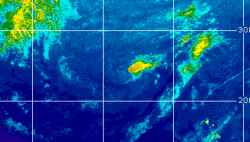cieldumort
Moderator

Reged:
Posts: 2664
Loc: Austin, Tx
|
 2017: HYPERACTIVE
2017: HYPERACTIVE
Wed Jun 14 2017 04:49 PM
|
|
|
Those of us who know a little bit about Atlantic basin history have been paying a little more attention to 2017.
First some background.
A few years ago speculation began in earnest that the most recent "active phase" of the Atlantic which is agreed by most to have begun in 1995, may have been winding down, or have even come to an end. As the argument went, numbers across the board started to fall apart in 2012 (despite late-season Sandy), and really turned inactive by 2013, subsequently remaining soft in both 2014 and 2015, as well. (See below - YEAR, NAMED STORMS, HURRICANES, MAJORS, ACCUMULATED CYCLONE ENERGY).
'THE ACTIVE ERA'
YEAR NS H M ACE
1995 19 11 5 228
1996 13 9 6 166
1997 8 3 1 41
1998 14 10 3 182
1999 12 8 5 177
2000 15 8 3 119
2001 15 9 4 110
2002 12 4 2 67
2003 16 7 3 176
2004 15 9 6 227
2005 28 15 7 250
2006 10 5 2 79
2007 15 6 2 74
2008 16 8 5 146
2009 9 3 2 53
2010 19 12 5 165
2011 19 7 4 126
2012 19 10 2 129
'THE END OF THE ACTIVE ERA' ?
2013 14 2 0 36
2014 8 6 2 67
2015 11 4 2 63
OR A PAUSE THAT LULLS?
2016, despite doing battle with lingering effects of a record El Niño, hinted that the 2013-2015 downswing may have been more related to short-term anomalies, such as the major El Niño in 2015, the driest mid-to-lower atmospheric conditions during the Aug. 1 to Sept. 25 period since reliable records began during 2013 (Klotzbach), and a related or unrelated (possibly temporary) downshift in the Atlantic Multi-decadal Oscillation (AMO), than anything else.
'El Niño favors stronger hurricane activity in the central and eastern Pacific basins, and suppresses it in the Atlantic basin.' - Climate.gov

The AMO is suspected by many to have alternating long-term negative/positive impacts on tropical cyclones in the Atlantic basin on time scales spanning several decades. The "postive" (Warm) phase of the AMO 'is associated with warmer than average oceans in the north and tropical Atlantic Ocean and an enhanced West African monsoon season, both of which boost hurricane development' - NHC.


SO ACTUALLY STILL IN AN ACTIVE PHASE?
LAST FIVE YEARS + AVG NHC *FORECAST FOR 2017
YEAR NS H M ACE
2012 19 10 2 129
2013 14 2 0 36
2014 8 6 2 67
2015 11 4 2 63
2016 15 7 4 141
2017* 14 7 3 n/a
Looking at all the stats above from 1995 on, 2016, and now the average NHC forecast for this year, certainly does not look much at all like what we might expect to see if the active era had truly come to a close. Maybe it's very possible that it is coming to a close, but just.. has not done so... yet (See image below). And if the active era is still in effect, the potential for a year with favorable conditions overall (favorable for tropical cyclones regardless of active or inactive phase) to work in tandem with the active era could mean a year that over achieves. 2017 could be such a year.
Below: AMO Indices 1950-2016

As Eric Blake pointed out in a tweet earlier this week, SST anomalies in the Atlantic indeed support the notion that 2017 could end up looking very much like an active season which occurs during the +AMO phase.

Credit: Eric Blake/Twitter
So it now looks like 2017 will at the very least not clearly be in the negative (low activity) phase of the AMO, and could still be in the active phase. Clues to then watch for indications that we may also be in an active season would include:
1. The state of El Niño–Southern Oscillation (ENSO). ENSO 'is an irregularly periodical variation in winds and sea surface temperatures over the tropical eastern Pacific Ocean, affecting much of the tropics and subtropics.'
At present ENSO-neutral or weak El Niño conditions are expected. If verified, these would tend to favor an average to active season, more so an inactive one.
2. SSTs across the MDR (Main Development Region). Warmer SSTs in this area strongly correspond with more active seasons.
According to the May 25 update from CPC, 'Currently, SSTs are above average across the MDR, with the largest departures of between +0.5° and +1°C observed in the Caribbean Sea. For the ASO season, SSTs have been above average in the MDR since 1995. However, there is typically low skill and considerable spread in model predictions of Atlantic SSTs this far ahead of the ASO season. Complicating this situation is the possible continuance of a strong cold bias in forecasts from NOAA's CFS high-resolution model that was evident during past two hurricane seasons. This model is again predicting well below-average SSTs in the MDR, while the lower-resolution CFS runs are predicting overall above-average SSTs in that region.'
3. Wind shear, and especially in the MDR. Weaker wind shear is more supportive for tropical cyclone development.
As of the May 25 update from CPC, 'At present, the model forecasts of vertical wind shear vary considerably from one model to the next, are generally dependent upon the model's predicted strength of El Niño. The CFS model is predicting anomalously weak shear in the MDR during ASO 2017. At present, there is no indication that the shear will be excessively weak so as to support an extremely active hurricane season, and also no confident indication that the shear will be exceptionally strong. The MDR will most likely experience near-average or below-average vertical wind shear during ASO 2017.'
4. Sea level pressures in the MDR. Lower pressures in this region are more supportive of development.
As of the May 25 update from CPC, 'pressures across the MDR are near average and forecasts from the various global models do not indicate large anomalies for either higher or lower pressure during ASO 2017.'
5. Saharan Air Layer (SAL) intrusions. SAL can cap convection. Additionally, SAL reduces the amount of sunlight reaching the ocean, and can thus lower SSTs. However, depending on the strength and relative location of the SAL at any given time, it can even aid in some tropical cyclone development situations.
'The Saharan Air Layer (SAL) is an elevated volume of warm, dry, and stable air, ranging in depth from generally 900 to 5500 m above the surface, that originates over the Sahara Desert in Northern Africa and propagates westward over the Atlantic basin, most often during summer months.' (AMS)
These intrusions of dry, subsident Saharan air are notoriously hard to predict, but early indications are not convincing that SAL will have a more negative or positive impact on development of storms this season.
|
|




 Flat
Flat








